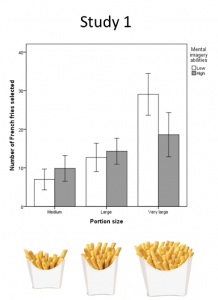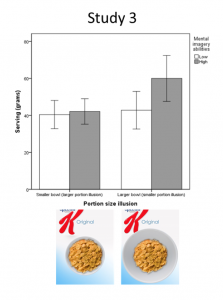Collaborators: Olivia Petit, Charles Spence, Andy t. Woods, Carlos Velasco, & Adrian D. Cheok
Abstract
A food portion is usually considered as a consumption norm, thus leading people to eat more in larger portions than in smaller portions. We propose that, by imagining the sensory experience of eating the food portion, it is possible to reduce the portion size effect. In study 1, consumers with higher mental imagery abilities selected less food in very large portions than consumers with lower mental imagery abilities (Figure 1). In study 2, consumers in the sensory imagery condition selected less food in larger portions than in smaller portions (Figure 2). In study 3, consumers with higher mental imagery abilities served themselves less food after seeing a larger portion illusion (i.e., the delboeuf illusion) on product packaging than after seeing a smaller portion illusion (Figure 3). Overall, consumers’ sensory mental imagery encourages them to find food more appetizing, have greater purchase intentions, and serve themselves less, thus benefitting consumers, the food industry, and public health.
Key words: food consumption, health, portion size, mental imagery, packaging, obesity
Figure 1: Number of French fries selected inside the portion by consumers with lower mental imagery abilities and consumers with higher mental imagery abilities in medium, large, and very large portions, in study 1. Error bars represent the 95% confidence intervals.
Figure 2: Number of chocolate’s squares selected in the medium and large chocolate bar sizes, by consumers in the control mental imagery and in the sensory mental imagery conditions, in study 2. Error bars represent the 95% confidence intervals.
Figure 3: Amount served by consumers with lower mental imagery abilities and consumers with higher mental imagery abilities in small bowl (larger portion illusion) and large bowl (smaller portion illusion) conditions, in Experiment 3. Error bars represent the 95% confidence intervals.



